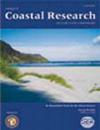Wave Group Effects on Breaker Height on a Uniform Slope
4区 地球科学
Q3 Earth and Planetary Sciences
引用次数: 3
Abstract
SHAND, T.D., PEIRSON, W.L. AND COX, R.J., 2007. Wave group effects on breaker height on a uniform slope. Journal of Coastal Research, SI 50 (Proceedings of the 9th International Coastal Symposium), 767 – 772. Gold Coast, Australia, ISSN 0749.0208 The maximum wave height that can be achieved during shoaling is of key importance in the design of coastal structures and the assessment of near shore currents and water levels. Previous investigations, upon which current design guidelines are based, have tended to focus on regular, monochromatic waves thereby neglecting group effects. Studies incorporating random wave testing include these group effects but may require prolonged testing periods to achieve the design condition. The shoaling transformations of wave groups as they progress into shallow water and break has been investigated in laboratory wave flume experiments. The water surface elevations were recorded by capacitance type wave probes. The type and position of breaking was recorded and video imaging used to observe wave kinematics during shoaling and breaking. Results show that the interaction of horizontal (intra-group) and vertical (depth-induced) energy fluxes plays a key role in the shoaling and breaking processes of the wave group. Notably, the evolutional stage of the wave group as it approaches a critical threshold depth facilitates the emergence of two distinct shoaling cases – an early shoaling case and a delayed shoaling case. These distinctive shoaling cases appear to cause significant variation in the wave breaking properties (breaker type and breaking position) and in the maximum depth limited wave heights (Hb/d) observed. In particular, the delayed shoaling case appeared to stabilise the wave groups, delaying breaking and yielding Hb/d ratios in excess of current design guidelines. These preliminary results indicate that current design guidelines based on monochromatic waves may underestimate the ‘worst case’ scenarios associated with wave groupiness with consequent implications for engineering design, coastal modelling and hazard mapping and planning. ADDITIONAL INDEX WORDS: Wave group, depth-limited wave breaking, shoaling, wave kinematics波群对均匀斜坡上断路器高度的影响
Shand, T.D., Peirson, W.L. and Cox, R.J., 2007.Wave group effects on breaker height on a uniform slope.Journal of Coastal Research, SI 50 (Proceedings of the 9th International Coastal Symposium), 767 - 772.The maximum wave height that can be achieved during shoaling is of key importance in the design of coastal structures and the assessment of near shore currents and water levels.目前的设计准则所依据的以往研究,往往侧重于规则的单色波,从而忽略了波群效应。采用随机波浪测试的研究包括这些波群效应,但可能需要较长的测试时间才能达到设计条件。实验室波浪水槽实验研究了波浪群进入浅水区和断裂时的浅滩变化。水面高程由电容式波浪探测器记录。记录了破浪的类型和位置,并利用视频成像技术观察了波浪在滑行和破浪过程中的运动学特性。结果表明,水平(波组内)和垂直(深度诱导)能量通量的相互作用在波组的趋波和断波过程中起着关键作用。值得注意的是,当波浪群接近临界阈值深度时,波浪群的演化阶段有利于出现两种不同的浅滩情况--早期浅滩情况和延迟浅滩情况。这些不同的滩涂情况似乎导致了破浪特性(破浪类型和破浪位置)和观测到的最大深度限制波高(Hb/d)的显著变化。特别是,延迟滩化情况似乎稳定了波群,延迟了破浪,产生的 Hb/d 比值超过了当前的设计准则。这些初步结果表明,以单色波为基础的现行设计准则可能低估了与波浪群相关的 "最坏 情况",从而对工程设计、海岸建模以及灾害绘图和规划产生了影响。补充索引词:波群、深度有限的破浪、浅滩、波浪运动学
本文章由计算机程序翻译,如有差异,请以英文原文为准。
求助全文
约1分钟内获得全文
求助全文
来源期刊

Journal of Coastal Research
地学-地球科学综合
自引率
0.00%
发文量
87
审稿时长
3-8 weeks
期刊介绍:
The Journal of Coastal Research (JCR) is one of the leading international journals for coastal studies and processes, and is published bi-monthly by the Coastal Education & Research Foundation [CERF]. By covering the entire field of coastal research, the JCR encompasses all subjects relevant to natural and engineered environments (freshwater, brackish, or marine) and the protection/management of their resources in the vicinity of coastlines of the world. Even though the journal broadly focuses on immediate shoreline zones, the JCR also embraces those coastal environments that either reach some indefinite distance inland or that extend seaward beyond the outer margins of the sublittoral (neritic) zone. The JCR disseminates accurate information to both the public and research specialists around the world on all aspects of coastal issues in an effort to maintain or improve the quality of our planet''s shoreline resources.
 求助内容:
求助内容: 应助结果提醒方式:
应助结果提醒方式:


